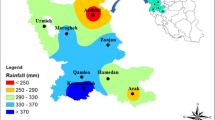Abstract
CIMMYT (the International Maize and Wheat Improvement Center) has routinely conducted international wheat yield trials to study the adaptation of spring bread wheat. The first of these, the International Spring Wheat Yield Nursery (ISWYN), was conducted for 31 years from 1964 to 1994 inclusive (30 cycles were conducted as no nursery was distributed in 1993 because of Karnal Bunt). Recently, pattern analysis methods have been developed and a set of computer programs written, which enable retrospective analyses of such historical databases to appraise the relationships among test environments in a way that discriminates among genotypes. Such an analysis was conducted on the 30 years of yield data from ISWYN and the classification derived from these analyses was compared with an agroecological classification of spring wheat test environments derived by CIMMYT. The incidence of foliar diseases (stem rust, leaf rust, yellow rust, Septoria spp. and Fusarium spp.) was important in the distinction between the high-rainfall low-latitude (mega-environment 2) and the high-input-irrigated low-latitude (mega-environment 1) environment types. The accumulation of resistance genes for these diseases has been an objective of the CIMMYT wheat breeding program. It was hypothesized that, as the relevant resistance genes were successfully pyramided into the germplasm, the distinction between these two mega-environment types would disappear. The results of the retrospective analyses support this hypothesis.
Similar content being viewed by others
Author information
Authors and Affiliations
Additional information
Received: 19 May 1999 / Accepted: 17 January 2000
Rights and permissions
About this article
Cite this article
DeLacy, I., Rajaram, S., Cooper, M. et al. The effect of the accumulation of disease resistance genes on the long-term association of a global sample of environments for testing spring bread wheat. Theor Appl Genet 101, 1164–1172 (2000). https://doi.org/10.1007/s001220051593
Issue Date:
DOI: https://doi.org/10.1007/s001220051593




